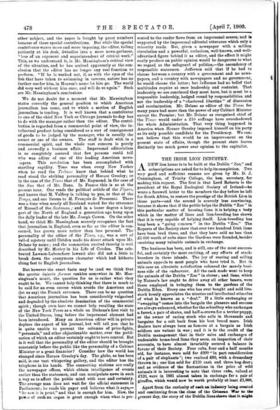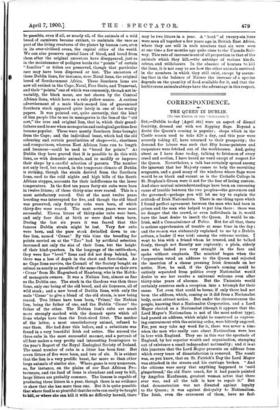THE IRISH LION INDUSTRY.
ANEW lion house is to be built at the Dublin "Zoo," and subscriptions are asked for to help its completion. Two very good and sufficient reasons are given by Mr. D. J. Cunningham, of Trinity College, the hon. secretary, for making this request. The first is that Lord Roberts is the president of the Royal Zoological Society of Ireland—he wrote a farewell letter to the members the day before he left for South Africa, to restore the prestige of the British Lion in those parts—and the second is scarcely less convincing, because it shows that if the public helps the Dublin " Zoo " in this particular matter of housing lions it is helping a body which in the matter of lions and lion-breeding has shown that it is very capable of helping itself. Lion-breeding has long been a " going concern " in the Dublin "Zoo." The Reports of the Society show that over two hundred Irish lions have been bred there, and that they have sold no less than £5.000 worth of cubs since the Gardens were founded, besides receiving many valuable animals in exchange.
The business has been, and is still, one of the most success- ful, and certainly the most exciting, of any efforts of stock- breeders in these islands. The joy of rearing and selling animals appeals to most people who have tried it. But in this case an altruistic satisfaction coloured the merely busi- ness side of the endeavour. All the cash made went to keep the animals of the Dublin " Zoo" in clover ; and lions, which by Nature's law ought to drive away all other beasts, were there employed in bringing them to the gardens of the Dublin Eden. Every one who has ever bought and sold live- stock keenly appreciates the niceties and intellectual stimulus of what is known as a "deal." If a little exchanging or "swapping" comes into the bargain the pleasure and success are always enhanced, whether for the schoolboy who exchanges a ferret, a pair of skates, and half-a-crown for a terrier puppy, or the owner of racing stock who sells in thousands and bargains for a colt back from his best brood mare. Irish dealers have always been as famous at a bargain as Irish soldiers are valiant in war ; and it is to the credit of the Dublin management that in their sales and exchanges of undeniable home-bred lions they seem, on inspection of their accounts, to have almost invariably secured a balance in favour of their Society. Four cubs, four and a half months old, for instance, were sold for £200 "in part consideration of a pair of elephants "; two realised £80, with a dromedary thrown in; one lion sold for £120 cash and three hog-deer; and as evidence of the fluctuations in the price of wild animals it is interesting to note that three calm valued at £120, were in 1881 almost taken in exchange for a pair of giraffes, which would now be worth probably at least £1,000.
Apart from the curiosity of eneh an indastry being-masted and continuing from the close of the Crimean War to the present day, the story of the Dublin lions shows that it might
be possible, even if all, or nearly all, of the animals of a wild breed of carnivora became extinct, to maintain the race as part of the living creatures of the planet by human care, even in its over-civilised areas, the capital cities of the world. We can also preserve special lines of blood, and breed from them after the original ancestors have disappeared, just as in the maintenance of pedigree herds the "points" of certain " families " or tribes are preserved, though that particular race may have been dispersed or lost. The ancestors of these Dublin lions, for instance, were Natal lions, the original breed of Southernmost Africa. These Southern lions are now all extinct in the Cape, Natal, Free State, and Transvaal, and their "points," one of which was commonly, though not in- variably, the black mane, are not shown by the Central African lions, which have as a rule yellow manes. A curious advertisement of a male black-maned lion of guaranteed Southern stock appeared quite lately in one of the weekly papers. It was pointed out, quite correctly, that the kind of lion people like to see in menageries is the lion of the " old sort," the true and original lion, that is, which their grand- fathers used to see when menageries and zoological gardens first became popular. These were mostly Southern lions brought from the Cape; and the individual beast, which had the old colouring and certain peculiarities of shape—viz., shortness and compactness, whereas East African lions ran to length and leanness—could be used to "breed for points." At Dublin they have proved that it is possible to do this with lions, as with domestic animals, and to modify or improve their shape by a careful selection of parents. The number not only bred, but reared, in the temperate climate of Dublin is striking, though the strain derived from the Southern lions, used to the cold nights and high hills of the South African steppes, accounts for their indifference to the lower temperature. In the first ten years forty-six cubs were born in twelve litters ; of these thirty-nine were reared. This is a most satisfactory record. Out of the next twelve years breeding was interrupted for five, and though the old blood was preserved, only forty-six cubs were born, of which thirty-five were reared. The next seven years were most successful. Eleven litters of thirty-nine cubs were born, and only four died at birth or were dead when born. During the last six years it was feared that this famous Dublin strain might be lost. Very few cubs were born, and the pure stock dwindled down to on, fine lion, named Omni.? By this time the breeding for points carried on at the "Zoo" had by artificial selection increased not only the size of their lions, but the height of their hind-quarters. In the language of the cattle-show, they were fine "level" lions and did not drop behind, but there was a loss of depth in the chest and fore-limbs. As no Cape lions survive, the Council of the Society bought an animal as nearly as possible of the same character as their own
Cesar' from Mr. Hagenbeck of Hamburg, who is the Moltke of menagerie owners. It was a Nubian lion, almost as fine as the Dublin one. The stock in the Gardens was then three lions, only one being of the old breed, and six lionesses, all of wild stock ; and a new breed of Dublin lions, with only the male Cmsar ' to give a blend of the old strain, is now being reared. Two litters have been born, Prince,' the Nubian lion, being the father of one, and the Dublin Cmsar ' the father of the other. The Nubian lion's cabs are much more strongly marked with the damask spots which all lions whelps have than the Irish-sired litter. The mother of the latter, a most unsatisfactory animal, refused to rear them. She had done this before, and a substitute was found in a very beautiful Irish red setter. She nursed the three cubs in the most successful manner, and a portrait of all four makes a very pretty and interesting frontispiece to the year's Report of the Royal Zoological Society of Ireland. The usual number of cubs in a litter has been four. Bnt seven litters of five were born, and two of six. It is evident that the lion is a very prolific beast., far more so than other large animals of similar size. Where game is very numerous, as, for instance, on the plains of our East African Pro- tectorate, and the food of lions is abundant and easy to kill, large litters are probably common. The lioness is capable of producing three litters in a year, though there is no evidence to show that she has more than one. But it is quite possible that where food is so plentiful that the cubs can easily be taught to kill, or where she can kill it with no difficulty herself, there may be two litters in a year. A " herd " of twenty-six lions were seen all together a few years ago in British East Africa, where they are still in such numbers that six were seen at one time a few months ago quite close to the Uganda Rail- way. This rate of increase is out of all proportion to that of the animals which they kill,—the antelope of various kin ds, zebras, and wildebeests. In the absence of hunters to kill the lions, it is not easy to see how the other animals survived in the numbers in which they still exist, except by assum- ing that in the balance of Nature the increase of a species depends on the quantity of food available for it, and that the herbivorous animals always have the advantage in this respect.







































 Previous page
Previous page